Bailando al ritmo de los sedimentos - The sediment dancers
Somos Tamara Manograsso Czalbowski, del Instituto Antàrtico Argentino, y Patrick Monien, del Instituto de la Química y la Biología del Mar de Alemania. [blog in Spanish and English]
Ambos estamos cooperando en el estudio de los sedimentos de la península y caleta Potter. Nuestro objetivo es caracterizar los minerales y la geoquímica de los mismos, y determinar los efectos del cambio climatico en el registro sedimentario. Para eso, colectamos muestras de diferentes lugares y formas.
Ayer hubo poco viento en la caleta y pudimos ir en bote en busca de las últimas muestras de sedimentos marinos de la campaña. En la primera foto vemos a Patrick levantar el dispositivo con el que se saca los testigos (tubos llenos de sedimentos). Es muy pesado y tenemos suerte que Patrick tenga mucha fuerza!!
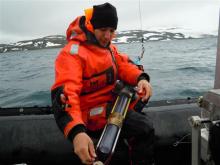 |
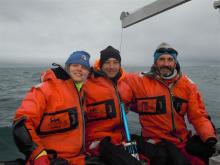 |
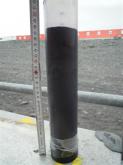 |
En la siguiente foto estamos los dos con Oscar “el Nono”. Oscar no sólo maneja los botes, sino que coordina todo lo referente a la navegación. Además tiene mucha experiencia que es sumamente necesaria para que los muestreos sean exitosos, y lo màs importante, es una excelente persona.
Pueden ver también como es el testigo que sacamos a 100 metros de profundidad!!! Los sedimentos allí son bastante fangosos y, aunque no lo parezcan, albergan muchas formas de vida: gusanos y caracoles entre los principales.
En el laboratorio, cortamos los testigos en rebanadas para analizarlos en un futuro. El mate, es muy importante en esta etapa. Nos da calor y compañía!!! Como pueden ver también. muestreamos sedimentos superficiales en la playa, en los lagos y ríos. Luego de un dia agotador de trabajo, no hay nada mejor para relajarse que bailar al ritmo del Saturday night fever!!!
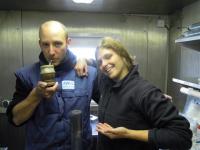 |
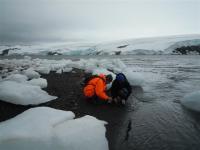 |
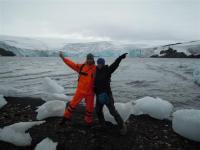 |
We are Tamara Manograsso Czalbowski from the Instituto Antàrtico Argentino and Patrick Monien from the Institute of Chemistry and Biology of the Sea (ICBM), University of Oldenburg (Germany), teamed up to study the sediments of Potter Peninsula. Our aim is to characterize the minerals and the chemistry of the sediments and to determine the effects of climate change in the region by studies of sedimentary archives. To do this, we collected samples in different sites and forms of soil.
Yesterday was one of the less windy days, and we could go by boat to take the last samples of this summer field season. In the first photo you can see Patrick with the drilling gear we are using obtain the sediment cores from the sea floor. It is very heavy and we are lucky that Patrick is such a strong guy! In the second foto ypu can see us together with Oscár “el Nono”. Oscár does not only drive the boat, but he also manages everything connected with navigation. With his experience and his knowledge of the cove, he helps us with this rather complicated sampling procedure and, above all, he is just the nicest person.
In the third photo you see one of the sediment containing plexi tubes (= cores) that we obtained at 100 m of water depth! At this depth the sediments are very muddy and, although one wouldn´t believe it, they are full of life: worms and snails are the principle colonizers of these sediments.
Back in the laboratory, we cut the sediment cores in vertical horizons for analysis. The “mate” is very important at this stage of the whole sampling process. He gives us warmth and he keeps us company when it's getting late.
Furthermore, we are taking samples of surface sediments on the beach, as well as in glacial lakes and rivers (foto middle). After the day of exhaustive work, there is nothing better than to relax at the Saturday night parties of Jubany!
Post your comment
Posting comments has been disabled.
Comments
-
Que linda sorpresa estuve buscando info sobre sedimentación y he encontrado a Tamy, que lindo que estés trabajando y divirtiendo, besos.
Ricardo del IGNPosted by Ricardo, 23/03/2011 4:00am (11 years ago)
RSS feed for comments on this page | RSS feed for all comments

